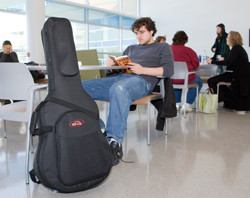Tyler move creates Temple arts hot spot
Built next door to Boyer and SCT, Tyler's new home makes Main Campus' northeastern corner a mini-campus for the arts
| With the arrival of the Tyler School of Art from the suburbs this spring, Temple's Main Campus in Philadelphia — long known for its performing arts programs — has become one of the most vibrant and diverse arts centers in the nation.
The completion of the Tyler's new, $75 million, state-of-the-art home adjacent to the Boyer College of Music and Dance's Presser Hall (which is connected by an atrium to Tyler) and the School of Communication and Theater's Annenberg Hall and Tomlinson Theater has created an arts mini-campus in the northeastern corner of Main Campus. The move unites Tyler's studio art programs in painting and drawing, sculpture, printmaking, photography, ceramics and glass, fibers, metals/jewelry/CAD-CAM and graphic and interactive design; Boyer's programs in music, dance and opera; SCT's programs in theater, film and media arts; and Tyler's preexisting Main Campus programs in architecture, art and art education and art history. For the first time in Temple's history, students and faculty in the performing and studio arts will be able to mingle, share |
 Photo by Joseph V. Labolito/Temple University
Sophomore Ryan McNeely, a jazz guitar performance major at the Boyer College of Music and Dance, reads in the new Tyler School of Art’s café. For the first time in Temple's history, students and faculty in the performing and studio arts will be able to mingle, share ideas, take courses in other disciplines and collaborate on projects.
|
|
ideas, take courses in other disciplines and collaborate on projects without making the wearing 40-minute commute between Elkins Park and North Philadelphia. "This has been a long time coming," said Luke Kahlich, a professor of dance at Boyer and the chair of the Provost's Commission on the Arts. "Bringing the arts together will provide more opportunities for collaboration." "Being able to personally interact with artists in other disciplines is critical," he said. "The more interaction you can have with other creative minds, the more your own discipline is enriched." Students are already taking advantage of opportunities for artistic and professional growth. SCT junior Gregory Andrew Powell, who is majoring in theater with an emphasis in design, is taking "Silkscreen on Fabric I," a Tyler fibers course taught by Assistant Professor Lorraine Glessner. "I think it's great that Tyler is across the street," Powell said. "As a costume and set designer, sometimes you can't buy what you're looking for, so you have to make it yourself. By understanding how to print fabrics, I can learn how to do it in a cost-effective way. That's important with the way arts funding is right now." The arrival of Tyler's Exhibitions and Public Programs Department and its expansive new gallery spaces (see New galleries bring new life to Tyler exhibitions) also add to Main Campus' growing reputation as a destination for arts visitors and an economic engine for the city. Already the site of hundreds of exhibits, concerts, screenings and readings every year, Main Campus' status as the northern anchor of the Avenue of the Arts will be enhanced when renovations to Temple's historic Baptist Temple are completed, resurrecting the building as a premier venue for arts and cultural productions. "Tyler's move to the city is very exciting," said Gary Steuer, chief cultural officer and director of the Office of Arts, Culture and the Creative Economy for the City of Philadelphia. "To now have Tyler as part of Temple's Main Campus helps infuse the energy of the arts even more deeply into the life of the university, but also into the life and the economy of the city as a whole." |